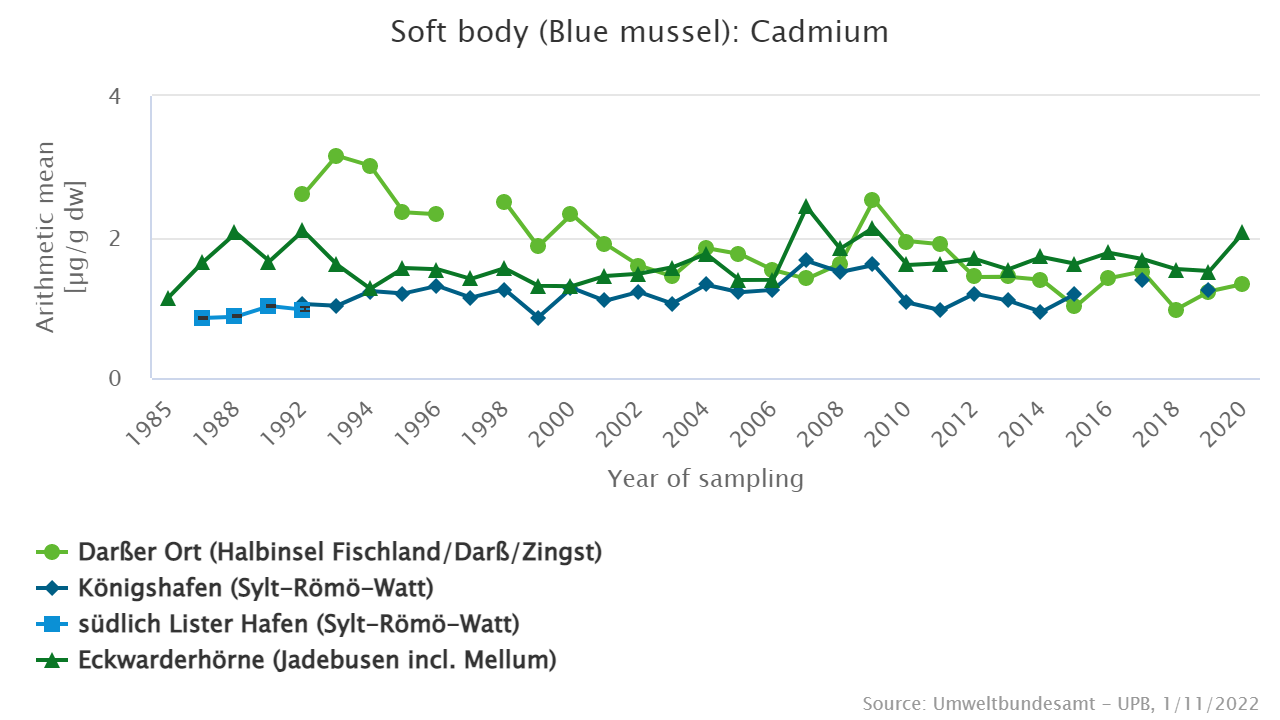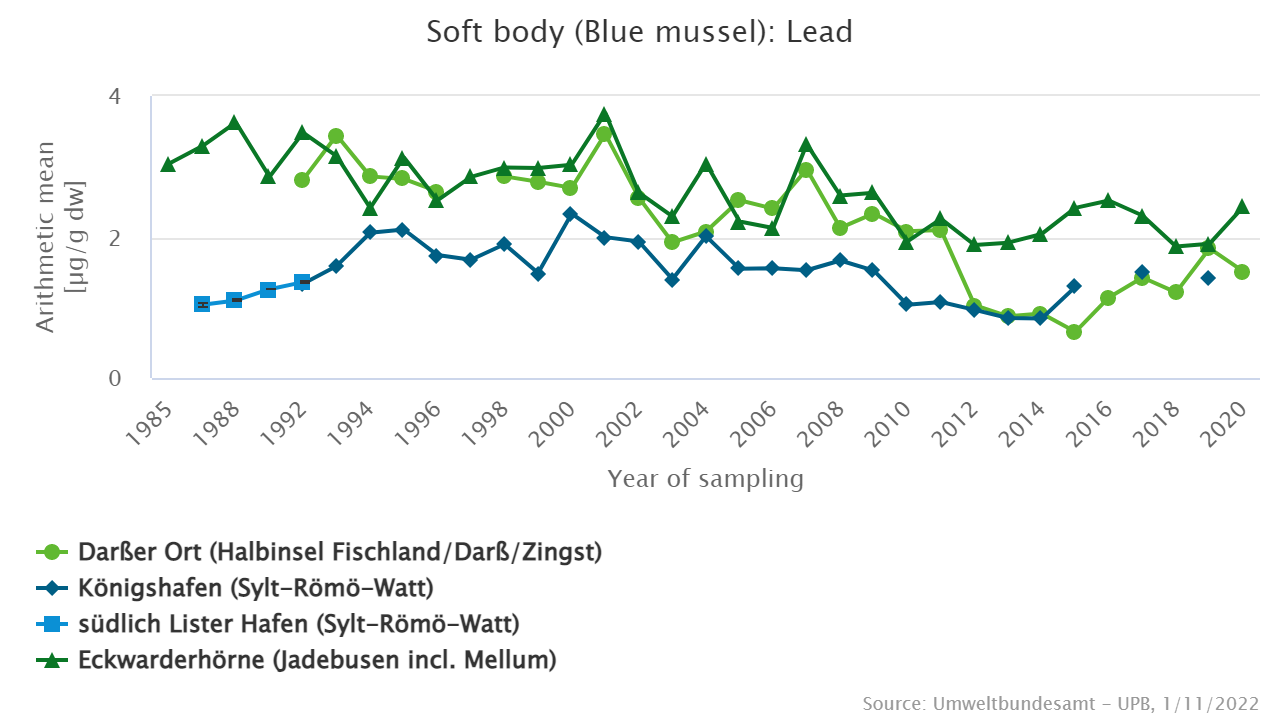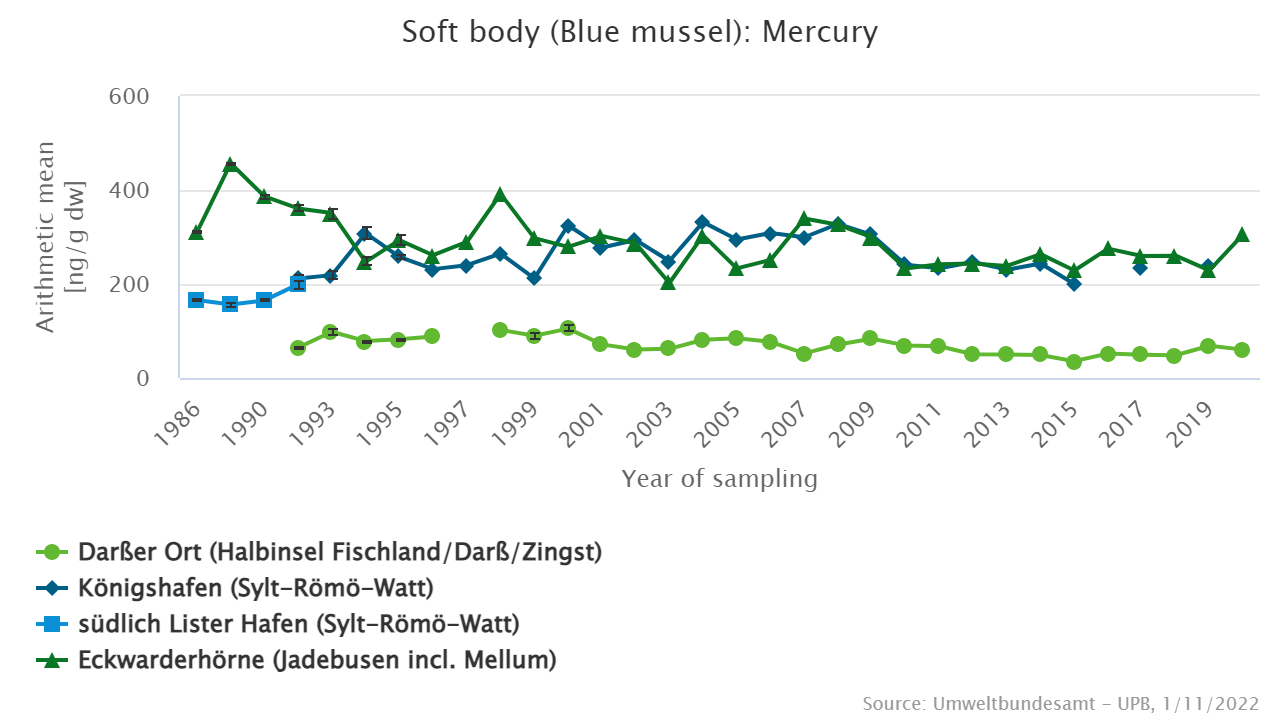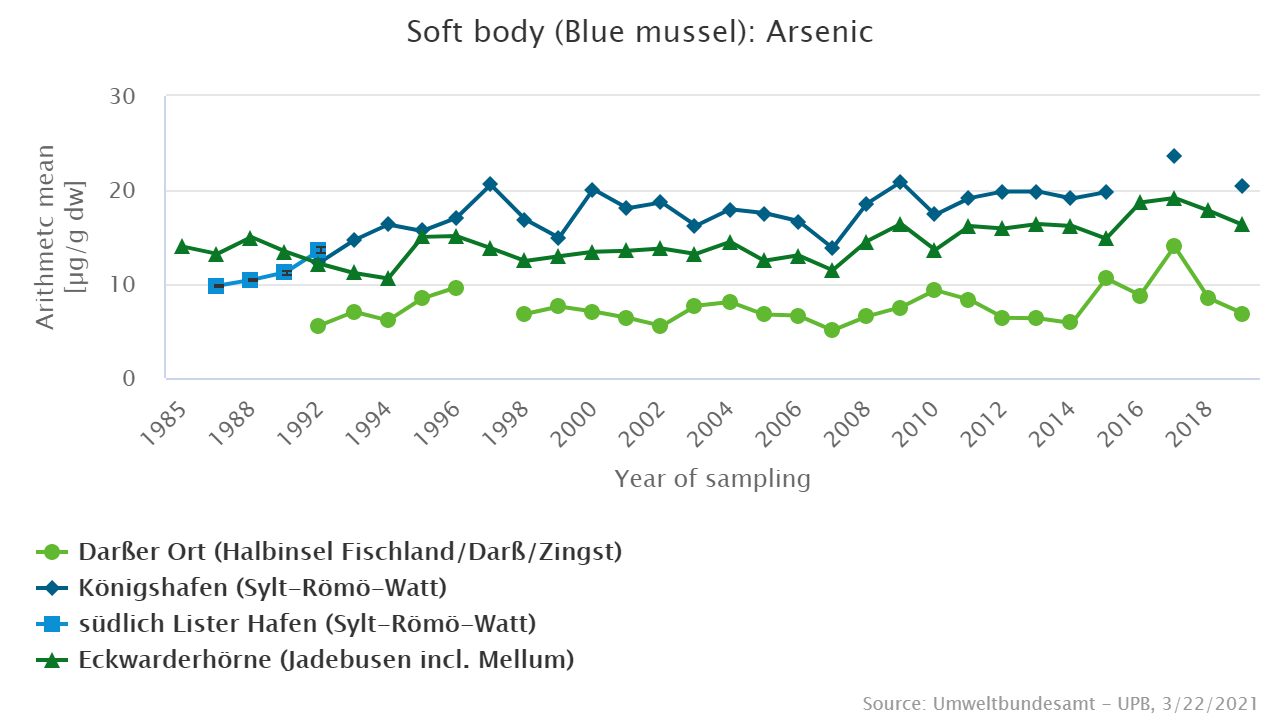Comparison between North Sea and Baltic Sea: Differences in levels of metals and arsenic in blue mussels
Blue mussels from the North Sea sampling sites Eckwarderhörne (Jadebay) and Südlich Lister Hafen/Königshafen (Sylt-Römö-Watt) have significantly higher mercury and arsenic contents compared to mussels from the Baltic Sea sampling site Darßer Ort. In contrast, cadmium levels are higher in Baltic Sea mussels. Lead concentrations are more or less the same in blue mussels from the sampling sites Darßer Ort and Eckwarderhörne whereas lower levels are observed in mussels from the Sylt-Römö-Watt. While nearly constant burdens are detected in mussels from Eckwarderhörne and Darßer Ort, concentrations of cadmium, mercury and arsenic have increased in mussels from the Sylt-Römö-Watt since the mid 1980s.
Blue mussels from both North Sea sites exceed the OSPAR background concentrations for cadmium, lead and mercury. Respective background concentrations for Baltic Sea mussels are not available yet.
Metal concentrations in environmental samples are the result of both, natural background concentrations and anthropogenic inputs. Furthermore, they are influenced by abiotic environmental factors. The same holds true for the non-metal arsenic.
In the North Sea and Baltic Sea, the main sources of arsenic and the heavy metals cadmium, lead and mercury are anthropogenic activities. The inputs differ between locations and lead to different element levels in biota. This can be shown using blue mussels from the three Environmental Specimen Bank sampling sites in the North Sea and Baltic Sea.
The highest cadmium levels are detected in mussels from the Baltic Sea sampling site Darßer Ort (mean: 2.1 ± 0.5 µg/g dry weight). During the study period, however, concentrations decreased slightly. Somewhat lower concentrations are found in mussels from the North Sea sites Eckwarderhörne (1.6 ± 0.3 µg/g dw) and Südlich Lister Hafen/Königshafen (1.2 ± 0.2 µg/g dw) (Figure 1). While no clear trend is apparent at Eckwarderhörne since the mid 1980s, cadmium levels increased significantly in mussels from the Sylt-Römö Watt.

Lead concentrations were highest in mussels from Eckwarderhörne (mean: 2.9 ± 0.5 µg/g dw) and the Baltic Sea sampling site Darßer Ort (2.6 ± 0.4 µg/g dw) (Figure 2). At both sites concentrations have decreased in the last ten years. Clearly lower lead contents but no trends with time are detected in mussels from the North Sea site Südlich Lister Hafen/Königshafen (1.6 ± 0.4 µg/g dw).

Significant differences between the North Sea sampling sites on the one hand and the Baltic Sea site on the other can be observed for mercury in blue mussels (figure 3). In Baltic Sea mussels mean mercury contents are 79.0 ± 14.6 ng/g dw and no trend over time is noticeable. Considerably higher levels are found in North Sea mussels, i.e. 256 ± 54 ng/g dw at Südlich Lister Hafen/Königshafen and 305 ± 60 ng/g dw at Eckwarderhörne. At Eckwarderhörne a slight decrease can be observed since the mid 1980s whereas concentrations have increased significantly in mussels from the Sylt-Römö-Watt.

Differences between the North Sea and Baltic Sea can also be observed for arsenic (figure 4). Mussels from the Baltic Sea site Darßer Ort have relatively low arsenic concentrations (mean 7.1 ± 1.2 µg/g dw) which remained more or less within the same range during the whole study period. Much higher arsenic levels are found in North Sea mussels with mean concentrations of 16.1 ± 3.1 µg/g dw in the Sylt-Römö-Watt and 13.4 ± 1.4 µg/g dw at Eckwarderhörne. Like mercury, arsenic levels have increased in mussels from the Sylt-Römö Watt since the beginning of the study, while no trend is noticeable at the sampling site Eckwarderhörne.

Conclusions
Differences between the Environmental Specimen Bank sites in the North Sea and the Baltic Sea are first of all apparent for mercury and arsenic. Both elements are clearly higher in North Sea mussels as compared to mussels from the Baltic Sea.
In contrast, cadmium concentrations were mostly higher in Baltic Sea mussels although differences were not as pronounced as for mercury and arsenic.
The North Sea sampling area Südlich Lister Hafen/Königshafen was the only location where contamination (i.e., with cadmium, mercury and arsenic) significantly increased during the study period whereas at both other sites contaminant levels either decreased or remained more or less stable.
Data assessment
The heavy metal contamination of mussels from the North Sea sites can be evaluated using reference values developed by the OSPAR Commission. The respective background concentrations for mussels reflect the natural heavy metal loads whereas higher concentrations are considered as result of anthropogenic inputs.
The OSPAR background concentration for cadmium in blue mussels is 600 ng/g dry weight (= 0.6 µg/g dw). This value is exceeded at both North Sea sites: During the entire monitoring period cadmium levels ranged between 0.9 and 1.7 µg/g dw in mussels from the Sylt-Römo-Watt and between 1.1 and 2.4 µg/g dw in mussels from Eckwarderhörne.
The same is true for lead and mercury: Since monitoring started in the 1980s, lead and mercury levels in blue mussels are clearly higher than the respective OSPAR background concentrations of 800 ng/g dw (= 0.8 µg/g dw) for lead and 90 ng/g dw for mercury (i.e. lead concentrations in blue mussels during the study period: Sylt-Römo-Watt: 1.0 - 2.3 µg/g dw; Eckwarderhörne: 1.9 - 3.8 µg/g dw; mercury contents: Sylt-Römo-Watt: 157 - 332 ng/g dw; Eckwarderhörne: 202 - 457 ng/g dw).
Since no such reference values are available for blue mussels from the Baltic Sea, a similar evaluation is not possible.
Updated at: 2022-01-11
Extended information
Literature
-
Twenty years of elemental analysis of marine biota within the German Specimen Bank - a thorough look at the data
Rüdel, Heinz; Fliedner, Annette; Kösters, Jan; Schröter-Kermani, Christa
Environ Sci Pollut Res 17 (2010), 5, 1025-1034, 2010